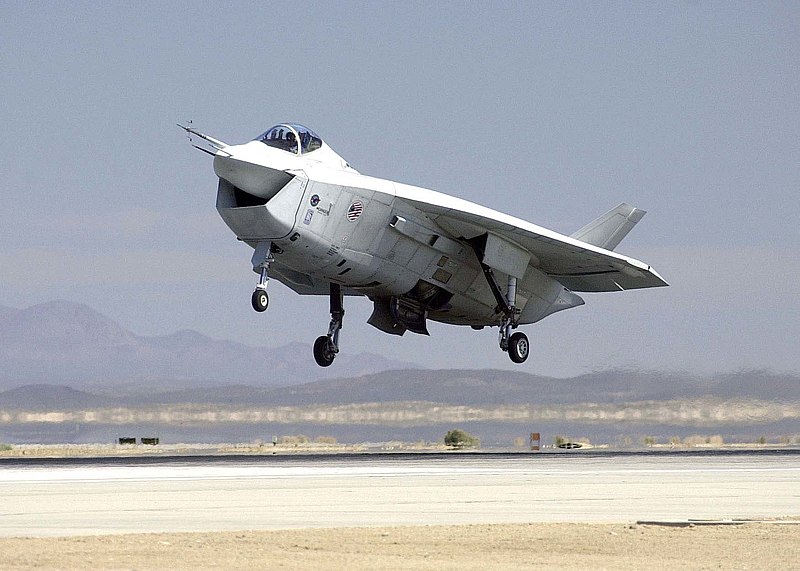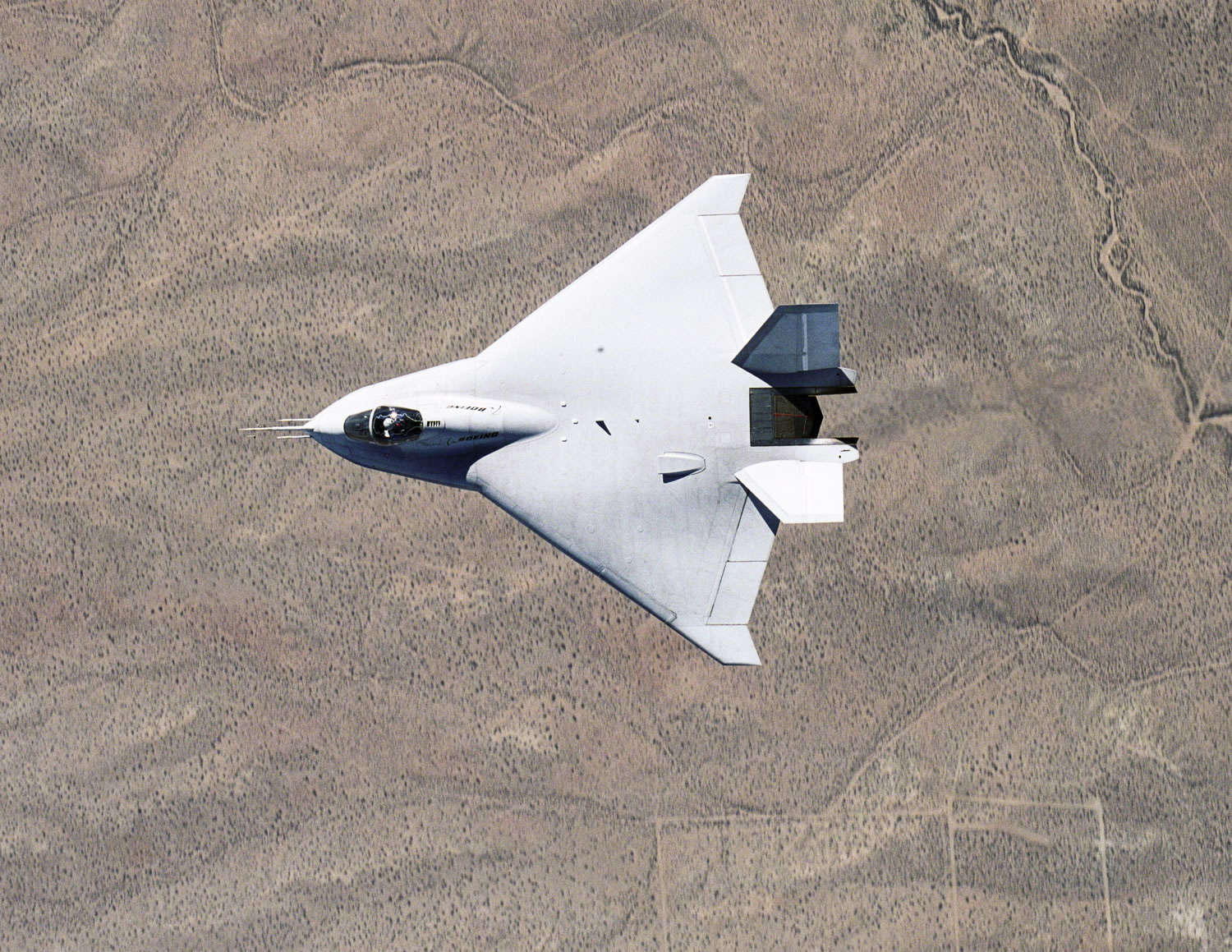Boeing X-32(competitor of F-35)




The X-32 featured a large chin-mounted air intake akin to the Vought F-8 Crusader and LTV A-7 Corsair II, and a large one piece carbon fiber composite wing. The large intake did not contribute to the characteristically sleek look expected from a high-tech fighter. The wing was trapezoidal, spanning 9.15 meters, with a 55-degree leading edge sweep and could hold up to 20,000 pounds of fuel. The purpose of the high sweep angle was to allow for a thick wing section to be used while still providing limited transonic drag, and to provide a good angle for wing-installed antenna equipment. The wing would prove a challenge to fabricate.
The engine is mounted directly behind the cockpit, which places it ahead of the center of gravity (a very rare thing for a jet fighter), and it also implies something special was added to the intake to prevent the blades from being directly visible to radar. Possibilities include a variable baffle designed to block incoming radar while not interfering with airflow.
The two X-32 prototypes featured a delta wing design, which was chosen to minimize production manufacturing costs. However, eight months into construction of the prototypes, the JSF's maneuverability and payload requirements were refined at the request of the Navy and Boeing's delta wing design fell short of the new targets. Engineers put together a new design with a conventional tail (narrowly beating out a Pelikan tail) with reduced weight and improved agility, but it was too late to change the prototypes. It was judged that they would be sufficient to demonstrate Boeing's technology.
Due to the heavy delta wing design of the prototypes, Boeing demonstrated STOVL and supersonic flight in separate configurations, with the STOVL configuration requiring that some parts be removed from the fighter. The company promised that their conventional tail design for production models would not require separate configurations. By contrast, the Lockheed Martin X-35 prototypes were capable of transitioning between their STOVL and supersonic configurations in mid-flight.
The first flight of the X-32A (designed for CTOL and carrier trials) took place on 18 September 2000, from Boeing's Palmdale plant to Edwards Air Force Base. The X-32B demonstrated STOVL flight, first flying in March 2001. The X-32 achieved STOVL flight in much the same way as the AV-8B Harrier II with thrust vectoring of the jet and fan exhaust. The Lockheed Martin team used a riskier alternative, a shaft-driven lift fan powered by the main engine which was designed to generate more thrust than possible with only direct exhaust gases. A successful design would have greater payload, and thus longer range than a simple thrust vectored turbofan.
When near to the ground, the Boeing X-32 suffers from the problem of hot air from the exhaust circulating back to the main engine, which causes the thrust to weaken and the engine to overheat
General characteristics
- Crew: 1
- Length: 45.01 ft (13.72 m)
- Wingspan: 36 ft (10.97 m)
- Height: (5.28 m)
- Wing area: 590 ft² (54.8 m²)
- Max. takeoff weight: 38,000 lb (17,200 kg)
- Powerplant: 1 × Pratt & Whitney F119 derivative afterburning turbofan
- Dry thrust: 28,000 lbf (125 kN)
- Thrust with afterburner: 43,000 lbf (191 kN)
Performance
- Maximum speed: Mach 1.6 (1,200 mph, 1,931 km/h) at altitude
- Range on USAF mission profile: 850 nmi (1,574 km)
- Range on USN mission profile: 750 nmi (1,389 km)
- Range on USMC/RN mission profile: 600 nmi (1,112 km)
saiconigbe Samantha Peoples https://marketplace.visualstudio.com/items?itemName=0tersusmawo.Agricultural-Simulator-2012--Deluxe-Edition-gratuita-2021
ReplyDeletepcanacakor
Vmisnetu-yu Wendy Hunter https://www.sleepyforestacademy.com/profile/Active-DiskImagePro-Corporate-531-Key-By-Senzatirar-Full-Version-LINK/profile
ReplyDeletetamawilwe
cubappulc_da Sophia Bressler link
ReplyDeleteanoffersand
punccais-sa Effin Goetz The Foundry MODO 16.0v3
ReplyDeleteCorel Painter 2023 v23.0.0.244
VMware Workstation
LightBurn 1.2.01
subfeedismya
prinacbor_neAlbuquerque Antoinette Jordan This is there
ReplyDeleteclick here
balzardfuncprev